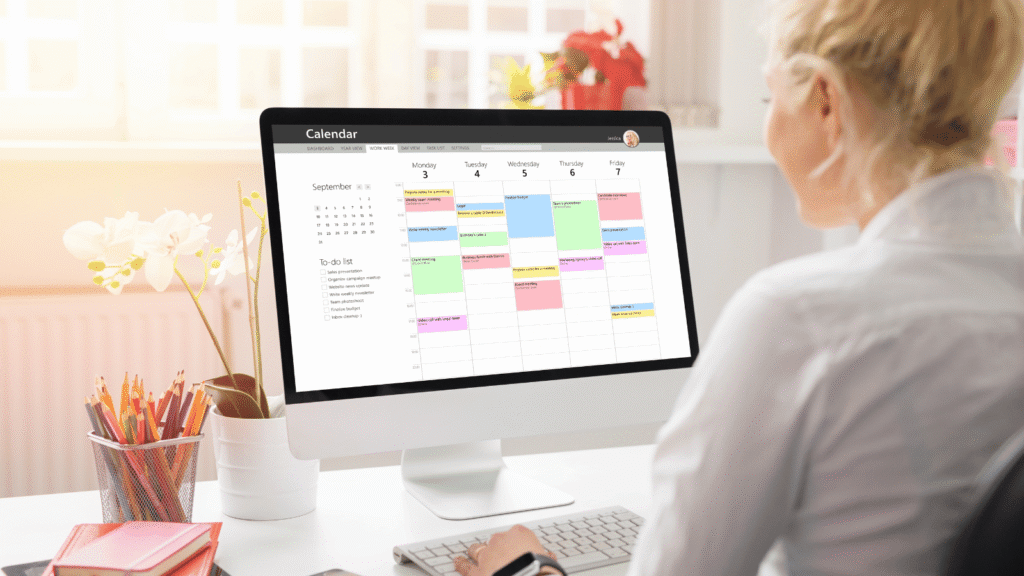Success is not just about talent or luck—it’s often the result of strong work habits that keep us focused, disciplined, and consistent. The way we structure our daily routines can either set us up for achievement or hold us back in cycles of stress and procrastination. When we intentionally shape habits that boost productivity, we’re essentially laying down the foundation for long-term success. The truth is, developing powerful work habits takes time and effort, but the return is enormous. With the right practices, we don’t just get more done—we feel more purposeful, motivated, and in control of our lives.
- Start the Day with a Clear Plan
- Prioritize Deep Work Over Busy Work
- Set Clear Goals and Track Progress
- Master the Art of Time Management
- Adopt Continuous Learning and Skill Development
- Maintain a Healthy Work-Life Balance
- Practice Effective Communication
- Develop Consistency and Discipline
- Leverage Technology Wisely
- Embrace Reflection and Self-Improvement
- Final Thoughts
- FAQs
Start the Day with a Clear Plan
Starting the day with a plan is more than just writing down tasks—it’s about creating direction, focus, and intention. A clear plan helps reduce decision fatigue and allows us to hit the ground running instead of wasting precious time figuring out what to do first. When we wake up with clarity, it sets a positive tone for the entire day.
One effective way to plan is to separate tasks into categories of importance. A simple table can help bring structure:
| Priority Level | Task Type | Example |
|---|---|---|
| High | Critical goals for the day | Preparing a client presentation |
| Medium | Important but flexible tasks | Reviewing emails or reports |
| Low | Routine, non-urgent activities | Organizing files, admin work |
Using this method ensures that the most valuable work gets done first, while less urgent tasks can be scheduled later.
Another practical approach is to break the day into focused blocks of time. For instance:
- Morning: High-focus work requiring creativity or problem-solving
- Afternoon: Collaborative tasks like meetings or brainstorming
- Evening: Low-stakes tasks that require less energy
The goal is not to schedule every single minute but to provide a roadmap that makes the day intentional. Even a simple plan brings a sense of control and helps us avoid drifting into distractions. Over time, this daily clarity becomes a powerful work habit that builds consistency and long-term success.

Prioritize Deep Work Over Busy Work
Deep work is about focusing on the tasks that truly move the needle, not just the ones that make us feel busy. While it’s tempting to tick off quick tasks like emails or minor admin work, these often don’t create meaningful progress toward bigger goals. Deep work requires uninterrupted concentration and mental energy, but it delivers higher-value outcomes in return.
To better understand the difference, consider this simple comparison:
| Busy Work | Deep Work |
|---|---|
| Answering routine emails | Writing a strategic report |
| Attending unnecessary meetings | Designing a project blueprint |
| Checking notifications constantly | Developing a new skill |
| Rearranging spreadsheets | Solving complex problems |
The key is to consciously shift time and energy away from low-value busy work and into tasks that create long-term results. One helpful practice is scheduling blocks of time specifically for deep work. During these sessions, distractions are minimized, and full focus is given to a single meaningful task.
Another effective strategy is asking ourselves before starting a task: “Will this matter a year from now?” If the answer is no, it’s likely busy work. If the answer is yes, it deserves deep work attention.
Deep work isn’t just about productivity—it’s about impact. By prioritizing it daily, we ensure that the hours we invest are building something significant rather than just filling the day. If you struggle with staying focused, my ebook The Procrastination Reset offers practical strategies to help you cut through distractions and finally get things done with clarity and confidence.
Set Clear Goals and Track Progress
Setting goals gives us direction, but tracking them ensures we stay on course. When we know exactly what we’re aiming for, it’s easier to align our daily actions with our bigger vision. A clear goal is like a map—it shows us the destination and the steps we need to take to get there. Without it, we risk pouring time and energy into tasks that don’t really move us forward.
One effective way to create stronger goals is to make them specific and measurable. Instead of saying, “I want to improve my productivity,” we might set a goal like, “I will complete three major projects this quarter.” This kind of clarity makes progress visible and easier to evaluate.
Tracking progress can be as simple or as advanced as we want it to be. Some people prefer journals, while others use digital apps or spreadsheets. What matters is that we measure consistently. Tracking also allows us to celebrate small wins along the way, which builds momentum and motivation.
A simple table like this can help organize goals and progress:
| Goal | Timeframe | Progress | Notes |
|---|---|---|---|
| Finish writing project | 3 months | 40% complete | Stay on schedule with weekly drafts |
| Improve fitness routine | 8 weeks | 5/8 workouts per week | Increase consistency |
| Learn new software | 1 month | 70% complete | Practice 3 times per week |
Breaking goals into smaller milestones is another helpful strategy. Instead of focusing only on the final outcome, we acknowledge progress at different stages. This approach reduces overwhelm and makes the process feel manageable.
When we combine goal setting with progress tracking, we create accountability, clarity, and steady forward movement. It’s not just about what we want to achieve—it’s about ensuring we’re actually moving toward it every single day.

Master the Art of Time Management
Time management is not just about getting more done—it’s about directing energy toward what matters most. One of the most powerful ways to strengthen this habit is by becoming intentional with how we allocate every hour of the day. Instead of reacting to tasks as they come, we take control by planning and structuring our time.
A practical approach is to identify “high-value tasks” versus “low-value tasks.” High-value tasks are those that push us closer to our long-term goals, while low-value tasks often keep us busy without creating meaningful progress. To make this distinction easier, consider using a simple priority system:
- Urgent and Important: Tasks that must be handled immediately (e.g., deadlines, crises).
- Important but Not Urgent: Long-term projects and growth activities that deserve focused time.
- Urgent but Not Important: Tasks that can often be delegated, like certain emails or calls.
- Neither Urgent nor Important: Time-wasters, such as excessive scrolling or unproductive meetings.
Breaking the day into time blocks can also make a huge difference. For example, reserving mornings for deep, focused work and afternoons for lighter administrative tasks can align with natural energy patterns. Even small adjustments—like grouping similar tasks together or setting strict start and end times—can prevent hours from slipping away unnoticed.
Finally, managing time effectively requires flexibility. Plans can shift, but having a structure to return to keeps us anchored. By making thoughtful choices about where our time goes, we reduce stress, protect energy, and create space for the work that truly matters.
Adopt Continuous Learning and Skill Development
Continuous learning is one of the most valuable work habits we can develop because it ensures we stay adaptable in a fast-changing world. No matter the industry, technology, and best practices are always evolving, which means our skills must evolve too. By making learning a daily or weekly habit, we keep ourselves sharp, relevant, and ahead of the curve.
The beauty of skill development is that it doesn’t need to be overwhelming. Small, consistent efforts add up over time. For example, reading one article a day, listening to a podcast on your commute, or dedicating 20 minutes each evening to a new skill can have a big impact when practiced consistently.
Here are a few practical ways to make continuous learning part of your routine:
- Read books or listen to audiobooks related to your field.
- Take online courses on platforms like Coursera, Udemy, or LinkedIn Learning.
- Join professional communities where you can exchange ideas and insights.
- Attend webinars or workshops to stay updated with industry trends.
- Learn transferable skills such as communication, problem-solving, or leadership.
Skill development doesn’t only apply to professional growth—it also improves personal fulfillment. Picking up a creative hobby, learning a new language, or exploring an area outside of work can expand perspective and boost cognitive flexibility.
To make the most of this habit, it helps to set clear learning goals and track progress. A simple table like this can help you stay organized:
| Skill Area | Learning Method | Time Commitment | Progress Check |
|---|---|---|---|
| Public Speaking | Online course + practice | 3 hrs/week | Monthly review |
| Data Analysis | Tutorial + real projects | 4 hrs/week | Project-based |
| Stress Management | Mindfulness + reading | 15 mins/day | Weekly journal |
If you ever feel your mind is too restless or cluttered to focus on learning, my ebook The Quiet Mind Toolkit can help you build the mental clarity needed to learn effectively and retain information with ease.

Maintain a Healthy Work-Life Balance
Finding the right balance between work and personal life is essential for long-term productivity and happiness. It’s not just about avoiding burnout; it’s about making sure we have enough energy, focus, and joy to perform at our best both in the office and at home. When we neglect balance, stress levels rise, relationships suffer, and our effectiveness drops. On the other hand, a healthy balance fuels creativity, motivation, and resilience.
One way to strengthen this habit is by setting clear boundaries. Deciding when the workday starts and ends helps prevent professional responsibilities from spilling over into personal time. It also sends a message to ourselves and others that rest and recovery are non-negotiable. Even simple changes like disabling email notifications after hours or creating a dedicated workspace at home can make a big difference.
Equally important is making time for activities that recharge us. Exercise, hobbies, and meaningful time with loved ones aren’t luxuries—they’re part of a balanced life that supports high performance. Regular breaks throughout the day, even short ones, give the mind space to reset and return with more focus.
A few practical ideas include:
- Scheduling non-work activities with the same importance as meetings
- Taking short walking breaks to reduce mental fatigue
- Practicing mindfulness or meditation to manage stress
- Protecting weekends for rest and personal connections
Maintaining work-life balance isn’t about splitting time equally—it’s about giving both work and life the attention they need at the right moments. By treating balance as a habit rather than an afterthought, we create a lifestyle that allows success to be both sustainable and enjoyable.
Practice Effective Communication
Clear communication is more than just exchanging information—it’s about ensuring understanding. When we communicate effectively, we minimize confusion, speed up collaboration, and build trust with colleagues and clients. Poor communication, on the other hand, can cause delays, misunderstandings, and even conflict, which directly affects productivity.
One way to strengthen this habit is by practicing active listening. This means not just hearing words but truly paying attention to the meaning behind them. When we listen carefully, we respond thoughtfully, which helps conversations flow more smoothly.
Another important aspect is clarity. Long, vague explanations often create more confusion than they solve. The most effective communicators simplify their message and focus on what the listener really needs to know.
Tone also plays a role. Whether in person, on a call, or through email, a professional and respectful tone ensures that the message is well-received. Choosing words carefully can prevent misunderstandings and maintain positive relationships.
Here are a few practical communication habits that can make a big difference:
- Listen more than you speak to fully understand the other person.
- Use simple and direct language to avoid confusion.
- Ask clarifying questions instead of assuming.
- Pay attention to non-verbal cues such as body language or tone of voice.
- Summarize key points at the end of a conversation to confirm understanding.
When we adopt these habits, communication becomes a tool for efficiency instead of a barrier. Effective communication doesn’t just make work easier—it creates stronger relationships, smoother teamwork, and better outcomes for everyone involved.

Develop Consistency and Discipline
Consistency and discipline are the invisible forces behind every great achievement. While talent and motivation might get us started, it’s discipline that ensures we keep going when the initial excitement wears off. Consistency is what turns small actions into powerful results over time. Together, these two habits create reliability—not just for others who depend on us, but for ourselves as well.
One way to think about consistency is as a form of self-trust. Each time we follow through on a commitment, we’re proving to ourselves that we can be relied upon. This builds confidence and reduces the mental resistance we often feel before starting important tasks. Discipline adds structure to that consistency, helping us resist short-term temptations in favor of long-term benefits.
Practical ways to strengthen consistency and discipline include:
- Set clear routines: Begin and end your day with predictable actions, such as morning planning or evening reflection.
- Use small wins: Break big goals into smaller steps and celebrate progress along the way.
- Limit decision fatigue: Reduce unnecessary choices by automating or scheduling repetitive tasks.
- Track habits visually: Use calendars, journals, or apps to monitor daily progress and stay accountable.
Consistency and discipline don’t need to feel rigid or punishing. In fact, they create more freedom because we no longer waste energy deciding what to do or battling procrastination. The more we practice them, the easier it becomes to stay aligned with our bigger goals.
Leverage Technology Wisely
Technology can be an incredible ally when it’s used with intention. The right digital tools save time, improve organization, and enhance focus. But the wrong approach—like checking notifications every five minutes or juggling too many apps—can leave us overwhelmed and unproductive. Building the habit of leveraging technology wisely means making conscious choices about which tools support our goals and which ones distract us.
For example, productivity apps can help us streamline tasks, track progress, and collaborate with others more efficiently. Automation can reduce repetitive work, freeing up energy for higher-value projects. Cloud storage ensures our files are accessible anytime, anywhere, while communication platforms help teams stay aligned without unnecessary meetings.
Here are some simple ways technology can boost productivity when used correctly:
- Automation tools for repetitive tasks like emails, scheduling, or invoicing.
- Project management software to keep work organized and deadlines clear.
- Focus apps that block distracting websites or limit social media usage.
- Cloud-based tools that allow easy collaboration and access across devices.
- AI assistants to draft, brainstorm, or analyze data quickly.
The key is not to adopt every shiny new tool but to choose only what genuinely supports our work habits. By setting clear boundaries—such as disabling non-essential notifications or designating specific times for checking messages—we prevent technology from becoming a distraction. In the end, technology should amplify our productivity, not control it.
If you find yourself constantly battling digital distractions, my ebook Digital Detox for the Restless Mind offers a practical guide to reclaiming your focus and creating healthier tech boundaries.

Embrace Reflection and Self-Improvement
Reflection is more than just looking back—it’s about gaining perspective that can guide smarter decisions moving forward. By taking a few minutes at the end of each day or week to pause and review, we give ourselves the chance to learn from experiences instead of rushing past them. This habit builds clarity, resilience, and self-awareness, which are key ingredients for success.
One effective way to practice reflection is by asking structured questions such as:
- What did I accomplish today that I’m proud of?
- What challenged me the most, and how did I respond?
- What can I do differently next time to improve the outcome?
Keeping a reflection journal can make these insights more tangible. Writing down lessons learned not only helps us remember them but also reveals patterns over time. When we notice recurring obstacles, we can create strategies to overcome them.
Self-improvement grows naturally from reflection because it gives us the information we need to take action. Whether it’s refining work processes, adjusting our mindset, or building new skills, reflection turns experience into progress. Over time, this habit transforms small adjustments into meaningful growth, making us more effective and adaptable in every aspect of work and life.
Final Thoughts
Developing strong work habits is about small, consistent actions that, over time, lead to big results. Whether it’s starting the day with a clear plan, embracing deep work, or learning how to manage our time, each habit creates a foundation for both productivity and success. By also prioritizing balance, communication, and continuous self-improvement, we don’t just work harder—we work smarter and with greater purpose.
If you’re ready to sharpen your focus and reduce procrastination, I encourage you to check out my ebook The Procrastination Reset. It’s filled with tools and strategies to help you stay consistent and productive without burning out.
FAQs





